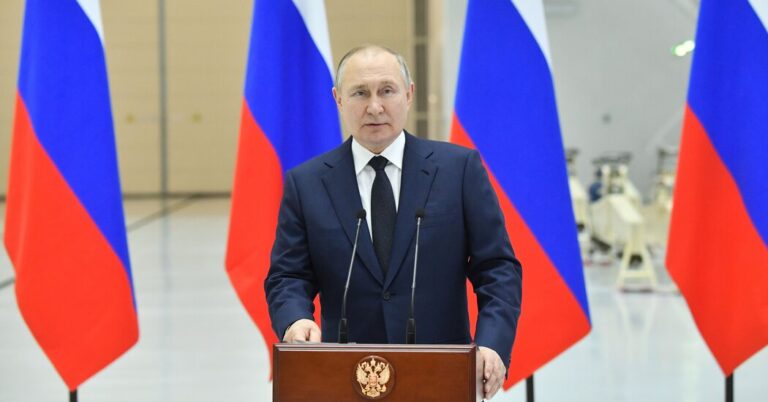Omens of Decline for Russia’s Once World-Leading Energy Industry
It was to be a hugely ambitious project on the frigid Gulf of Ob, in Russia’s Far North, a steppingstone in Moscow’s rising ambitions to be a power in liquefied natural gas much as it is in oil and gas delivered by pipeline.
When President Vladimir V. Putin of Russia launched his war on Ukraine, the $21 billion project known as Arctic LNG 2 was well underway with dozens of wells drilled, an airport built and most of the equipment ordered.
Now, though, European Union sanctions that prohibit the sale of gas liquefaction equipment to Russia have thrown the giant complex into doubt. The sanctions mean, at best, that just one of three planned liquefaction facilities at Arctic LNG is likely to be completed anytime soon, analysts say.
The project’s key international backer, TotalEnergies, recently wrote off its $4.1 billion investment. It is “difficult to believe that it can be built with the sanctions,” Patrick Pouyanne, the TotalEnergies chief executive, told analysts in late April.
The problems go far beyond L.N.G.
In coming years Russia is likely to be forced into retreat across a wide spectrum of energy. Future growth for its oil and gas exports — for decades the backbone of the country’s economy — are now deeply uncertain. The shock waves from Ukraine even extend into nuclear power, where Finland recently shelved a deal for Russia to build an estimated 7 billion euro ($7.4 billion) reactor.
“Russia is going to be a greatly diminished international player, there is no question about it,” said Matt Sagers, vice president and head of Russian and Caspian energy at S & P Global, a financial services firm.
Russia will probably find markets for at least some of its oil and gas; in April Mr. Putin said that while the country may lose traditional buyers, it would find more at home and abroad. But it may gradually lose influence in the industry, becoming a pariah to former international partners like the major international oil companies.
Some analysts also say it is hard to see how Moscow can remain a co-chair, with Saudi Arabia, of the oil producers’ organization known as OPEC Plus. So far, though, Saudi officials and others are sticking with Russia with an eye toward preserving cohesion in the group for a distant future date when the world is oversupplied with oil rather than worried about shortages.
L.N.G. is effectively a proxy for Russia’s energy ambitions. It is fast-growing, largely because the chilled liquid can be transported around the world on ships, allowing a country like Russia, whose gas is now delivered largely by pipelines to increasingly hostile customers in Europe, to reach any market with a suitable terminal. Handling the chilled gas is also technically challenging.
L.N.G. is still in its infancy in Russia, but Moscow aimed to vie with world leaders: Qatar, Australia and the United States. It would capitalize on its enormous gas resources and its relationships with Exxon Mobil and Shell as well as TotalEnergies, which owned 10 percent of Arctic LNG 2. All are big players in liquefied gas. (L.N.G. imports have been growing at about 7 percent per year.)
Such ambitions have now been dashed. Analysts at S & P Global now estimate that Russia will likely have only half the L.N.G. gas capacity it was targeting by the end of the decade. An Exxon Mobil liquefied gas project on Sakhalin Island, in Russia’s Far East, has been shelved, and Shell has said it would exit Russia’s first L.N.G. facility, also on Sakhalin Island.
In oil and gas, the setbacks can be divided into two broad categories. With international oil giants like Shell, BP and Exxon Mobil having announced their intention to leave Russia, the Russian industry will lose access to advanced technologies and capital. For example, Russia’s gas giant Gazprom has been working with Shell on using chemical mixes to boost oil extraction in a project called Salym, which Shell is now exiting.
In the past, Russia’s vast fields have generally been easy to tap, but after decades of pumping, the remaining petroleum will be harder to extract. “The longer Russia is shunned from the system, the greater the downside risk for production,” Oswald Clint, an analyst at Bernstein, a research firm, wrote in a recent report.
But a more immediate concern is the fact that Russia has been forced to shut down oil production because of the sanctions and the reluctance of buyers to handle Russian crude and oil products.
In one sign of such distress, the oil project operated by Exxon Mobil on Sakhalin Island in the Russian Far East has shipped no oil so far in May, according to Kpler, a firm that tracks energy shipping. Exxon Mobil declared force majeure at Sakhalin, meaning it could no longer perform its obligations because of conditions outside of the company’s control. Exxon said that it was having difficulty “complying with its obligations” and “conducting operations at the required level of international standards.”
Russia does not have a large oil storage system, and so when it is unable to export oil, it is forced to throttle back wells or completely shut them down. There is nowhere to put the oil. Russian oil output declined by 900,000 barrels a day, or 10 percent, in April compared with March. The International Energy Agency, the Paris-based group, said recently that the amount of reduced production could approach 3 million barrels a day later this year.
The Russia-Ukraine War and the Global Economy
A far-reaching conflict. Russia’s invasion on Ukraine has had a ripple effect across the globe, adding to the stock market’s woes. The conflict has caused dizzying spikes in gas prices and product shortages, and is pushing Europe to reconsider its reliance on Russian energy sources.
And in a sign that more taps may be closed, analysts at Kayrros, a research firm, said that oil on tankers has been increasing rapidly. This suggests “Russia might again be finding it more difficult to dispose of its crude,” they said.
Russia has had some success in finding buyers for oil that otherwise might have gone to Europe and the United States. Flows to India have ramped up. Viktor Katona, an analyst at Kpler, said that China, where energy consumption has fallen off due to Covid lockdowns, appears to be stepping up its buying.
Russia is also making money, thanks to high petroleum prices. Analysts at S & P Global estimate that Russia made about $26 billion on sales of natural gas to Europe from the beginning of the war in Ukraine on Feb. 24 through the end of April, more than three times the period a year earlier. Of this total, about a quarter went directly to the government and about half went to Gazprom, the gas monopoly. Around $5 billion went to Asian and Western L.N.G. investors. (Tax exemptions meant to encourage L.N.G. investment mean the chilled gas now produces little revenue for the Russian government.)
Analysts say it would be wrong to underestimate Russia’s oil industry. It was struggling when the Soviet Union collapsed in the early 1990s, but righted itself with the aid of Western companies and has since absorbed technologies like fracking and horizontal drilling. Despite sanctions imposed to punish Mr. Putin’s takeover of Crimea in 2014, Russia managed to increase production to a peak in 2019.
Novatek, the Russian company developing Arctic LNG 2, has even deployed a largely homegrown L.N.G. technology on an earlier project with TotalEnergies, called Yamal L.N.G. But the process has encountered problems and it remains unclear whether it can work at full commercial scale. Novatek declined to comment.
“I wouldn’t say they are finished as a petroleum power,” Mr. Clint, the Bernstein analyst, said in an interview. “But they are certainly knocked down the ranking for a good period of time.”
Check out our Latest News and Follow us at Facebook
Original Source







